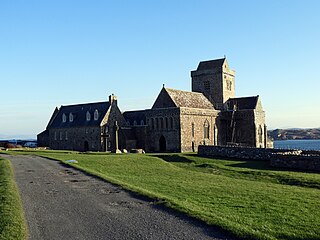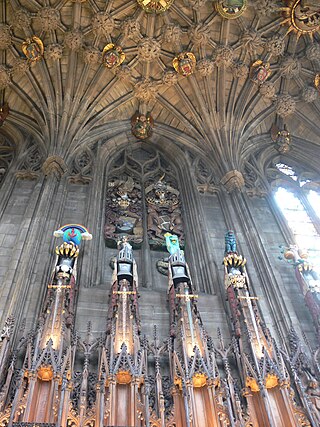
The Most Ancient and Most Noble Order of the Thistle is an order of chivalry associated with Scotland. The current version of the order was founded in 1687 by King James VII of Scotland, who asserted that he was reviving an earlier order. The order consists of the sovereign and sixteen knights and ladies, as well as certain "extra" knights. The sovereign alone grants membership of the order; they are not advised by the government, as occurs with most other orders.

Rosslyn Chapel, formerly known as the Collegiate Chapel of Saint Matthew, is a 15th-century Episcopal chapel located in the village of Roslin in Midlothian, Scotland.

St Giles' Cathedral, or the High Kirk of Edinburgh, is a parish church of the Church of Scotland in the Old Town of Edinburgh. The current building was begun in the 14th century and extended until the early 16th century; significant alterations were undertaken in the 19th and 20th centuries, including the addition of the Thistle Chapel. St Giles' is closely associated with many events and figures in Scottish history, including John Knox, who served as the church's minister after the Scottish Reformation.

A chapel royal is an establishment in the British and Canadian royal households serving the spiritual needs of the sovereign and the royal family.

Virginia Theological Seminary (VTS), formally called the Protestant Episcopal Theological Seminary in Virginia, located at 3737 Seminary Road in Alexandria, Virginia is the largest and second oldest accredited Episcopal seminary in the United States.

Iona Abbey is an abbey located on the island of Iona, just off the Isle of Mull on the West Coast of Scotland.

Greyfriars Kirk is a parish church of the Church of Scotland, located in the Old Town of Edinburgh, Scotland. It is surrounded by Greyfriars Kirkyard.

Craigmillar, from the Gaelic for 'the rock of the bare summit', is an area of Edinburgh, Scotland, about 3 miles (4.8 km) south east of the city centre, with Duddingston to the north and Newcraighall to the east.

Edinburgh: The New Town Church of Scotland serves Edinburgh's New Town, in Scotland. It is a congregation of the Church of Scotland, formed on 1 February 2024 by the union of St Andrew's & St George's West and Greenside Church.

Sir Iain Richard Torrance, is a retired Church of Scotland minister, theologian and academic. He is Pro-Chancellor of the University of Aberdeen, Honorary Professor of Early Christian Doctrine and Ethics at the University of Edinburgh, President and Professor of Patristics Emeritus at Princeton Theological Seminary, and an Extra Chaplain to Her Majesty Queen Elizabeth II in Scotland. He was formerly Moderator of the General Assembly of the Church of Scotland, Dean of the Chapel Royal in Scotland, and Dean of the Order of the Thistle. He is married to Morag Ann, whom he met while they were students at the University of St Andrews, and they have two children.

Heinz Memorial Chapel is a Pittsburgh History and Landmarks Foundation Historic Landmark and a contributing property to the Schenley Farms National Historic District on the campus of the University of Pittsburgh in Pittsburgh, Pennsylvania, United States.

The Cathedral Church of Saint Mary the Virgin, commonly known as St Mary's Episcopal Cathedral, is a cathedral of the Scottish Episcopal Church in the West End of Edinburgh, Scotland; part of the worldwide Anglican Communion.

Augustine United Church is a United Reformed Church in Edinburgh, Scotland. It is in a local ecumenical partnership with St Columba's-by-the-Castle and Greyfriars Tolbooth and Highland Kirk.

The Princeton University Chapel is a Collegiate Gothic chapel located on that university's main campus in Princeton, New Jersey, United States. It replaces an older chapel that burned down in 1920. Designed in 1921 by Ralph Adams Cram in his signature style, it was built by the university between 1924 and 1928 at a cost of $2.3 million. The chapel was rededicated in an interfaith ceremony in 2002 following a major two-year restoration.
Louis Reid Deuchars (1870–1927) was a Scottish artist and sculptor.

Church music in Scotland includes all musical composition and performance of music in the context of Christian worship in Scotland, from the beginnings of Christianisation in the fifth century, to the present day. The sources for Scottish Medieval music are extremely limited due to factors including a turbulent political history, the destructive practices of the Scottish Reformation, the climate and the relatively late arrival of music printing. In the early Middle Ages, ecclesiastical music was dominated by monophonic plainchant, which led to the development of a distinct form of liturgical Celtic chant. It was superseded from the eleventh century by more complex Gregorian chant. In the High Middle Ages, the need for large numbers of singing priests to fulfill the obligations of church services led to the foundation of a system of song schools, to train boys as choristers and priests. From the thirteenth century, Scottish church music was increasingly influenced by continental developments. Monophony was replaced from the fourteenth century by the Ars Nova consisting of complex polyphony. Survivals of works from the first half of the sixteenth century indicate the quality and scope of music that was undertaken at the end of the Medieval period. The outstanding Scottish composer of the first half of the sixteenth century was Robert Carver, who produced complex polyphonic music.

The history of popular religion in Scotland includes all forms of the formal theology and structures of institutional religion, between the earliest times of human occupation of what is now Scotland and the present day. Very little is known about religion in Scotland before the arrival of Christianity. It is generally presumed to have resembled Celtic polytheism and there is evidence of the worship of spirits and wells. The Christianisation of Scotland was carried out by Irish-Scots missionaries and to a lesser extent those from Rome and England, from the sixth century. Elements of paganism survived into the Christian era. The earliest evidence of religious practice is heavily biased toward monastic life. Priests carried out baptisms, masses and burials, prayed for the dead and offered sermons. The church dictated moral and legal matters and impinged on other elements of everyday life through its rules on fasting, diet, the slaughter of animals and rules on purity and ritual cleansing. One of the main features of Medieval Scotland was the Cult of Saints, with shrines devoted to local and national figures, including St Andrew, and the establishment of pilgrimage routes. Scots also played a major role in the Crusades. Historians have discerned a decline of monastic life in the late medieval period. In contrast, the burghs saw the flourishing of mendicant orders of friars in the later fifteenth century. As the doctrine of Purgatory gained importance the number of chapelries, priests and masses for the dead within parish churches grew rapidly. New "international" cults of devotion connected with Jesus and the Virgin Mary began to reach Scotland in the fifteenth century. Heresy, in the form of Lollardry, began to reach Scotland from England and Bohemia in the early fifteenth century, but did not achieve a significant following.

The Thistle Chapel, located in St Giles' Cathedral, Edinburgh, Scotland, is the chapel of the Order of the Thistle.

Scotland's Churches Trust is a Scottish registered charity whose “aims are to advance the preservation, promotion and understanding of Scotland’s rich architectural heritage represented in its churches and places of worship of all denominations.” Its principal activities are “promoting heritage and tourism” and “giving of grants”. It primarily carries out these activities by offering financial support and practical advice for church repairs and modernisation projects, organ recitals and concerts, a church recording scheme and by promoting its fourteen Pilgrim Journeys across Scotland, that include over 500 places of current or former worship.

Joseph Hayes (1869–1916) was a Scottish sculptor and art teacher. He is best known for the Thistle Chapel within St Giles Cathedral. His career was cut short when he was killed in the First World War.






















